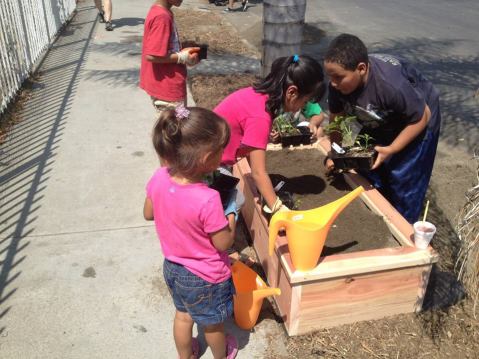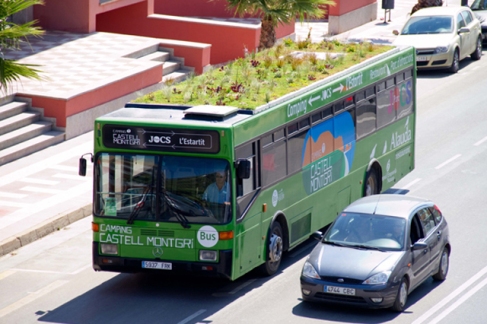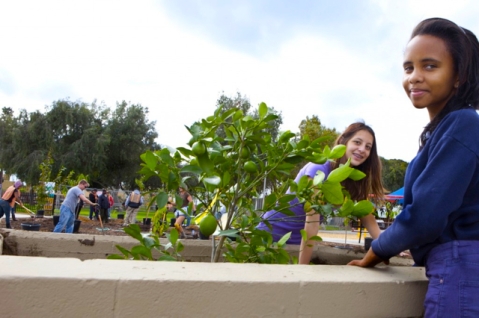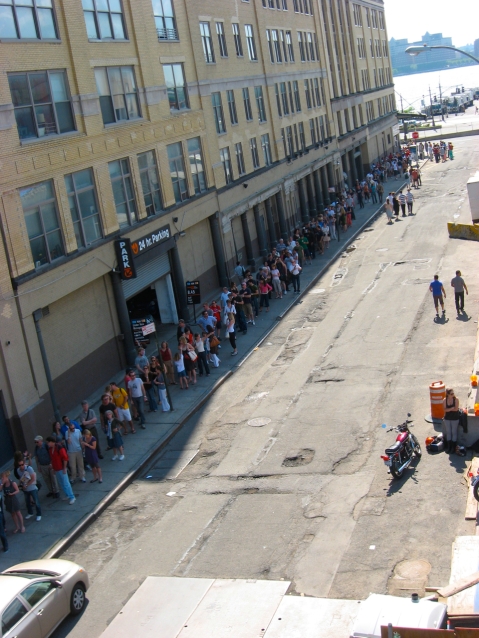LA Waves Parkway Planting Permits to Create Opportunities in Food Deserts
In my last post, I highlighted an innovative program in Toronto which brings a mobile produce market to communities who lack access to affordable and healthy food. In an effort to address healthy food access in similarly underserved neighborhoods across the US, some community residents have literally taken action into their own hands by transforming underutilized and sometimes unlikely patches of land into “guerrilla” gardens.
Trees, wildflowers, herbs, fruits and vegetables pop up in vacant lots, alleys, tree pits and even parkways (the planted strip of land between the curb and the sidewalk), providing aesthetic value, helping to oxygenated the air and clean the soil, as well as providing families with an opportunity for healthy eating. Parkways are often owned by a city but the responsibility for maintenance falls on the adjacent homeowner. These spaces have a lot of potential for urban gardening because they are right outside of a house or apartment building and are a manageable size. Some parkways go ignored, some become planted, and others become community resources.
In 2010, gardener and activist Ron Finley co-founded LA Green Grounds, a group who plants and tends gardens created in parkways and other underutilized spaces with the hope of creating a food and health revolution in underserved South Los Angeles. In 2013, Mr. Finely gave a TED Talk (above) where he discussed the inspiration for the parkway garden he created in front of his home. Mr. Finley, who grew up in South Los Angeles and raised his children there, asked the audience, “…I was wondering, how would you feel if you had no access to healthy food, if every time you walk out your door you see the ill effects that the present food system has on your neighborhood? I see wheelchairs bought and sold like used cars. I see dialysis centers popping up like Starbucks. And I figured, this has to stop. So I figured that the problem is the solution. Food is the problem and food is the solution. Plus I got tired of driving 45 minutes round trip to get an apple that wasn’t impregnated with pesticides.”
Prior to a 2013 amendment to the City’s “Residential Parkway Landscaping Guidelines”, it was illegal to plant fruits and vegetables in parkways, but due to the activism of Mr. Finley and many others, the LA City Council decided to make an exception for vegetable gardening. While this news was a step in the right direction for urban gardeners and community health advocates, the permit to plant anything other than grasses and certain shrubs, still carried a cost-prohibitive $400 price tag. But just this week, the LA City Council voted to waive the $400 fee for parkway gardens (excluding fruit trees). The City Council will still have to define the parameters of the law (regulating garden height and addressing concerns such as safe passage for pedestrians) and the ordinance will be subject to final Mayoral approval, but waiving the fee will be a significant win for advocates and paves the way to increase the opportunity for residents to bring fruits and vegetables in to their neighborhoods without the worry of fines hanging over their heads.
My Finley says: “I have witnessed my garden become a tool for the education, a tool for the transformation of my neighborhood. To change the community, you have to change the composition of the soil. We are the soil. You’d be surprised how kids are affected by this. Gardening is the most therapeutic and defiant act you can do, especially in the inner city. Plus you get strawberries.”
Your Garden Variety Bus
Designer Marc Granen decided to plant a garden on the roof of a bus. Yes, a bus.
If you’re in Spain, you might be able to catch a glimpse of the Phyto Kinetic in action. Granen and his team of designers have designed a lightweight rooftop garden with a multitude of uses. Granen says that his mission “is to expand the garden area in urban environments, increase the absorption of CO2 and give public transport a new ecological and tourist attraction”.
I appreciate Granen’s clever use of a space that we may not think of as underutilized and I think it would be exciting if these buses were able to help grow and deliver food to neighborhoods that have poor access to healthy food options. Maybe they could grow gardens on school buses and that food could feed the children!
Some buses have bicycle racks but front racks add space when the bus is parked and areas that have limited space (i.e. Manhattan) cannot afford the extra room. Utilizing the top of the bus, could provide a resource and not have to take up additional space.
A Park on the Stairs
While this mini-park would not be accessible to those with disabilities or strollers, it is a creative and important use of space providing seating and refuge amid the density of Hong Kong. The design of this park takes full advantage of the shape of the stairs and in doing so, appears to provide solitary or communal seating options as well as the ability to transform some of the seats in to tables which could be used during coffee and lunch breaks or to play chess with friends or games with children. One of the best elements of this mini-park is the trees which not only provides shade but also a protective canopy to its users.
Hong Kong’s stair park is similar to another imaginative project called Stair Squares. In 2007, artist Mark Reigelman created “squares” that were installed on the front steps of Brooklyn’s Borough Hall, helping to give the staircase a myriad of additional and more comfortable uses and turning it in to a more dynamic public space.
An Edible Orchard in Los Angeles
On Saturday, January 5th, a revamped Del Aire Park in Los Angeles’ South Bay was revealed to its neighbors. The new park received $4 million dollars in upgrades to its community center, basketball court, and baseball field and in addition to these upgrades, a grant was secured through the Los Angeles County Arts Commission Civic Art Program to plant 27 fruit trees at the park and an additional 60 fruit trees around the neighborhood.
The fruit park (the first of its kind in the state) was created in collaboration with The Office of Supervisor Mark Ridley-Thomas and the Los Angeles County Department of Parks and Recreation and planted by artist collective Fallen Fruit, a group that invites “the citizens of Los Angeles to reconsider their relationship with public and urban space to explore the meaning of community through sharing and creating new and abundant resources.”
At the opening of the park, Supervisor Mark Ridley-Thomas said that “Community gardens and farmers markets are truly the town centers of our communities,” and they become spaces where the community gets to know one another. These kinds of resources can also be incredible important in neighborhoods that do not have easy access to healthy foods.
Over time, the fruit trees in the park and around the neighborhood will grow and give the community plums, pomegranates, peaches, limes, avocados, and apricots, as well as grapes and edible herbs. A wooden sign by the orchard reads: “The fruit trees in this park belong to the public. They’re for everyone, including you. Please take care of the fruit trees and when the fruit is ripe, taste it and share it with others.”
Beneath the High Line
Today, the New York Times had a great opinion piece by Jeremiah Moss titled Disney World on the Hudson: In the Shadows of the High Line.
For me, the High Line is an innovative and unique reuse project, but one that also embodies exclusivity. The 1.45-mile-long park is located in a mostly swanky area of Manhattan, surrounded by chic shops and restaurants, expensive food trucks and sits literally high above the street (which can be an issue when elevated spaces can feel unwelcoming and exclusive). The park is accessible to some visitors by mulitiple stairways and less-abled visitors (or those encumbered with strollers for example) can access the long and winding park by select elevators. But those with any impairment or any sort of carriage must be careful not to trip over raised concrete design features that surround the planted areas embedded in the concrete surface of the park.
The Friends of High Line board boasts a few high-profile celebrities who live or work near the park (the website features a history of the High Line video narrated by the actor Ethan Hawke) and had managed to create such a buzz about the space that on opening day there was a line of people wrapped around the block, waiting (after they obtained an official wrist band) to explore this new “public” space, a handful at a time.
Many other cities around the country have looked to the High Line as a model of an innovative reuse project than can attract a lot of locals and tourists to a neighborhood but it may be important for them to take a closer look. Mr. Moss writes that the park “has become a tourist-clogged catwalk and a catalyst for some of the most rapid gentrification in the city’s history.”
As so often happens with gentrification, Mr. Moss fears that any remaining diversity of “regular New Yorkers” will soon vanish. He writes:”Within a few years, the ecosystem disrupted by the High Line will find a new equilibrium. The aquarium-like high rises will be for the elite, along with a few exclusive locals like the Standard Hotel. But the new locals will rarely be found at street level, where chain stores and tourist-friendly restaurants will cater to the crowds of passers-by and passers-through. Gone entirely will be regular New Yorkers, the people who used to call the neighborhood home. But then the High Line was never really about them.”













